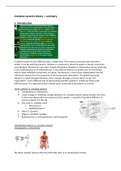Complex systems theory – summary
1. Introduction
A system consists of very different parts, components. They interact massively with eachother
locally. It can be anything (neurons, children in a classroom). What the system is doing is more then
one individual. Behavior is much more shaped will produce behavior or phenomena can be surprising
if you study behavior of an individual part. If you observe behavior of system you can not bring it
back to what individual components are doing. The behavior is much more shaped about how the
individuals interact then the properties of the components themselves. This global/surprising
behavior is called emergent behavior and it emerges through a process which we call ‘self-
organization’. A very different way of approaching scientific questions. Usually we study small
different parts. This approach doesn’t always work, so we look at the system as a whole.
Linear systems vs. Complex systems
• Components vs. Interactions
• Linear change vs. Nonlinear change (behavior of a complex system always evolves over time,
in linear you always take one snapshot of the system -> causality if therefore different, in
normal research if A then B)
• One scale vs. multiple scales
o Micro/macro
o Spatial/temporal
• Static vs. Dynamic
• Single vs. Multiple causality
• Reductionism vs. Self-organization and Emergence
Complicated systems vs. Complex systems
Components vs. interactions
We often complex systems what we preferably refer to as complicated systems.
,You talk about components (that can rotate), it’s even dynamic, each component has a function but
its predictable because if you know how each component works its logical.
If you want to understand one part of the system you need to more about the system. Everything is
connected to everything. You have to know more about the system then just component c. Human
behavior is one of the complex systems that you can come across. We treat the system as a very
complicated systems, if you understand every component of the systems you should know how the
body works but we think it doesn’t work like that. If you know about the components you know very
little about human behavior. We put across this work of self-organization, each of the grains of sand
will collide because it’s moving (film), idea of what the self-organizing system would look like. Each of
the components are very simple, grains of sand, system as a whole shows very surprising effects
(patterns).
Components
Reductionism:
- Reduces complicated problems into simpler parts
- System behavior = sum of component behavior
Interactions
Self-organization:
- Local interactions between components
- Global emergent system behavior
- Does not reduce to the behavior of the components
In a computer each component does one thing, we often map that into a brain. Usually the brain
consists out of water, sugar and fat (milkshake). How can we perform all this functions from a simple
set of components if they are not specialized as in a computer.
Components
Another way of showing how we look at
a cognitive system as a system with
components (attention, decoding etc.)
Everything that we are doing is because
of everything that those components do
individually (linear).
If the system doesn’t behave like it should
or could, its due to some default in one
component they would say. Absence of
one single component why how we
explain problematic behavior. Single
cause in a system that we have to cure.
,Interactions
Behavioral, neuro, and genetic studies at the group level often mask
important findings at the individual level.
This is not an average brain, individuals that are performing the same task, none of the brain
activities are overlapping. On average you can see differences in two different groups but individually
you can see different pictures. How can it be that if this brain component is responsible for a lack of
reading, but none if the individuals is showing this effect, how can it be the cause if default reading?
One reason of complexity is that we are going to look at how processes develop over time. How
strongly these processes are interacting rather then what is happening at one specific time scale.
➔ Snap ik niet dit plaatje?
What did we learn so far from linear statistics?
Statements about groups
• Women are more emotional than men
• Baby’s don’t have a ToM, whereas toddlers do
• Lesbians only have sex with women
• Adolescents are more impulsive than young adults
• People with ADHD have weakly developed EF
• Children with ASD display repetitive behavior
• Teachers are prejudiced against pupils from low-SES backgrounds
Statements are often linear
• The older one gets -> the less impulsive the behavior will be
• The weaker EF -> the stronger ADHD
• The more repetitive the behavior -> the clearer the autism
Compare means
Mean EFadhd < Mean EFcontrol
20 (SD = 3.4) < 24 (SD = 4.2) T test is significant, p < .05
Compute correlation
Age * Impulsiveness: r = -0.30, p < .05 , 9% variance explained
➔ This means that 91% is explained by something else -> might be the non-linear part
Run ANOVA
IV = Gender (Female vs. Male) and Group (Autistic vs. Control)
DV = Score on a test of Theory of Mind (ToM)
Effect of Gender: ToMfemale > ToMmale 3% of variance explained
Effect of Group: ToMautistic < ToMcontrol 10% of variance explained
Conclusions about the individual? OOPS, maybe later!!!
➔ If you work with individuals which is more likely, then with samples of participants, at that
point there is very little you can do bases on these statistics
, Scope of traditional statistics (overview)
only concern the group, not the individual
linear relationships (e.g., correlation, t test, ANOVA, regression)
components explain behaviour (IV + Noise => DV): Autism + noise -> ToM
independent components added together explain behaviour:
3% of the variance caused by gender + 10% by the group = 13% in total
Observed score = true score + noise; In formula: X1 = Τ + ε1
Scope of complexity theory
concern group and individual, measured over time
nonlinear relationships (e.g., phase transitions, CUSP catastrophe, small cause large effect and vice
versa)
interactions explain behaviour (local interactions ßà global pattern, emergence)
dependent components not A à B, entire system may matter
Observed score = dynamical change process; In formula: Xt+1 = f(Xt)
Linear vs. nonlinear change
Linear
A change in X is associated with a proportional change in Y
Nonlinear (more common)
A change in Y is not proportional to X
Far more common than linearity in human behavior
- Finger movement (at some point fingers move together)
- ‘Eep’-to-’pee’
- Transitions from walking to running
- Perceptual ambiguity
➔ Switches all of a sudden, either one or the other you can
see or do, difficult to see both of it at the same time






